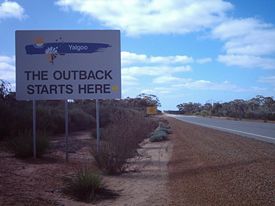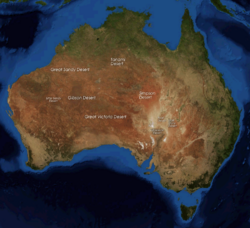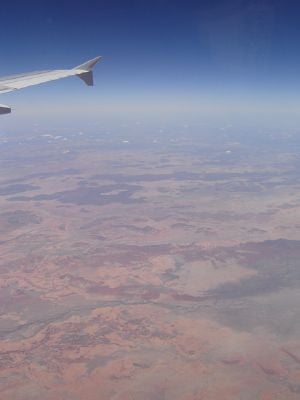Difference between revisions of "Great Australian Desert" - New World Encyclopedia
(→Agriculture: size) |
Laura Brooks (talk | contribs) (spacing, added category) |
||
| Line 1: | Line 1: | ||
| − | {{claimed}}{{Contracted}}{{Images OK}}{{submitted}} | + | {{approved}}{{claimed}}{{Contracted}}{{Images OK}}{{submitted}} |
| + | |||
[[image:Yalgoo Shire.jpg|thumb|275px|right|A tourism sign post Yalgoo, [[Western Australia]]]] | [[image:Yalgoo Shire.jpg|thumb|275px|right|A tourism sign post Yalgoo, [[Western Australia]]]] | ||
[[Image:ISS007 Gosses Bluff.jpg|thumb|275px|right|[[Gosses Bluff crater]], one of a number of [[meteor]] impact craters that can be found across outback Australia.]] | [[Image:ISS007 Gosses Bluff.jpg|thumb|275px|right|[[Gosses Bluff crater]], one of a number of [[meteor]] impact craters that can be found across outback Australia.]] | ||
| − | |||
The '''outback''', also known as the '''Great Australian Desert''', is the remote and arid interior and north of [[Australia]]. The term "outback" is also used colloquially to refer to other locations that are comparatively more remote than "the bush." Although the outback does not officially exist within any governmental frameworks or boundaries, many local government [[shire]]s use the term to enhance tourist appeal. | The '''outback''', also known as the '''Great Australian Desert''', is the remote and arid interior and north of [[Australia]]. The term "outback" is also used colloquially to refer to other locations that are comparatively more remote than "the bush." Although the outback does not officially exist within any governmental frameworks or boundaries, many local government [[shire]]s use the term to enhance tourist appeal. | ||
| Line 10: | Line 10: | ||
Less than ten percent of the Australian population lives outside the urban settlements on the coastal fringes. Despite this, the outback and the history of its exploration and settlement provides Australians with a mythical backdrop, and stories of [[swagmen]], [[squatters]], and [[outlaws]] such as [[Ned Kelly]] are central to the national ethos of the country. The song ''[[Waltzing Matilda]]'', is an iconic Australian outback song. | Less than ten percent of the Australian population lives outside the urban settlements on the coastal fringes. Despite this, the outback and the history of its exploration and settlement provides Australians with a mythical backdrop, and stories of [[swagmen]], [[squatters]], and [[outlaws]] such as [[Ned Kelly]] are central to the national ethos of the country. The song ''[[Waltzing Matilda]]'', is an iconic Australian outback song. | ||
| − | + | ==Agriculture== | |
| − | |||
[[Image:Australia-deserts.png|thumb|250px|Map showing locations of the Australian deserts.]] | [[Image:Australia-deserts.png|thumb|250px|Map showing locations of the Australian deserts.]] | ||
The marginally fertile parts, mainly within the [[Lake Eyre]] Basin, are known as rangelands and have been traditionally used for domestic [[sheep]] or [[cattle]] farming on sheep stations and cattle stations which are leased from the federal government. The outback is also home to the Australian feral [[camel]] and [[dingo]]es (wild dogs). The Dingo fence was built to restrict dingo movements into agricultural areas towards the south east of the continent. | The marginally fertile parts, mainly within the [[Lake Eyre]] Basin, are known as rangelands and have been traditionally used for domestic [[sheep]] or [[cattle]] farming on sheep stations and cattle stations which are leased from the federal government. The outback is also home to the Australian feral [[camel]] and [[dingo]]es (wild dogs). The Dingo fence was built to restrict dingo movements into agricultural areas towards the south east of the continent. | ||
| Line 17: | Line 16: | ||
Whereas these grassy areas have fairly fertile [[clay]] soils, the remainder of the outback has exceedingly infertile paleosols which cannot support [[fodder]] nutritious enough for the economic raising of stock. Although the north of Australia has high (if extremely seasonal) and fairly reliable rainfall, giving it almost all the continent's runoff water, the soils there are so poor and eroded (made mainly of [[ironstone]] or [[bauxite]]) as to make farming impossible even with [[fertilizer]]s such as super phosphate<ref>Wadham, Sir Samuel, Wilson, R. Kent and Wood, Joyce: '''Land Utilization in Australia''', pages 49-50. Cambridge University Press, 1957 (3rd edition)</ref>. | Whereas these grassy areas have fairly fertile [[clay]] soils, the remainder of the outback has exceedingly infertile paleosols which cannot support [[fodder]] nutritious enough for the economic raising of stock. Although the north of Australia has high (if extremely seasonal) and fairly reliable rainfall, giving it almost all the continent's runoff water, the soils there are so poor and eroded (made mainly of [[ironstone]] or [[bauxite]]) as to make farming impossible even with [[fertilizer]]s such as super phosphate<ref>Wadham, Sir Samuel, Wilson, R. Kent and Wood, Joyce: '''Land Utilization in Australia''', pages 49-50. Cambridge University Press, 1957 (3rd edition)</ref>. | ||
| − | + | ==Mining== | |
| + | |||
Along with agriculture, tourism and mining are the main economic activities in this vast and sparsely settled area. Due to the complete absence of mountain building and [[glaciation]] since the [[Permian]] (in many areas since the [[Cambrian]]) era, the outback is extremely rich in [[iron]], [[aluminum]], [[manganese]] and [[uranium]] ores. It also contains major deposits of [[gold]], [[nickel]], [[lead]] and [[zinc]] ores, as well as semi-precious [[gems]]. . | Along with agriculture, tourism and mining are the main economic activities in this vast and sparsely settled area. Due to the complete absence of mountain building and [[glaciation]] since the [[Permian]] (in many areas since the [[Cambrian]]) era, the outback is extremely rich in [[iron]], [[aluminum]], [[manganese]] and [[uranium]] ores. It also contains major deposits of [[gold]], [[nickel]], [[lead]] and [[zinc]] ores, as well as semi-precious [[gems]]. . | ||
| − | + | ==Tourism== | |
| + | |||
The outback is increasingly becoming a world tourist destination. Popular places include: | The outback is increasingly becoming a world tourist destination. Popular places include: | ||
| − | + | * Cooper Pedy, an underground, mining town known as the "[[Opal|Opal Capitol]] of the World" | |
| − | *Cooper Pedy, an underground, mining town known as the "[[Opal|Opal Capitol]] of the World" | + | * Alice Springs, a vibrant oasis in the middle of the Great Australian Desert |
| − | *Alice Springs, a vibrant oasis in the middle of the Great Australian Desert | + | * Ayers Rock (Aboriginal name: Uluru), lying 210 miles southwest of Alice springs, is the second largest [[monolith]] on earth, five miles around and almost a thousand feet high. |
| − | *Ayers Rock (Aboriginal name: Uluru), lying 210 miles southwest of Alice springs, is the second largest [[monolith]] on earth, five miles around and almost a thousand feet high. | ||
| − | |||
[[Image:Ayers-Rock.jpg|thumb|700px|center|Ayers Rock, also known by its Aboriginal name of Uluru, stands almost 1000 feet high with a circumference of five miles.]] | [[Image:Ayers-Rock.jpg|thumb|700px|center|Ayers Rock, also known by its Aboriginal name of Uluru, stands almost 1000 feet high with a circumference of five miles.]] | ||
| − | |||
Organized road travel to the outback is also popular, although some Australian and international tourists travel in their own vehicles. Such a trip, particularly once off the few bitumen roads in the outback, requires considerable advance planning and a suitable vehicle (usually a four wheel drive.) On remote routes considerable supplies and equipment may be required, this can include prearranged caches. Some trips cannot be undertaken safely with a single vehicle instead requiring a convoy approach. Deaths from tourists and locals becoming stranded on outback trips occur, and rescues for the ill-prepared are a regular occurrence. | Organized road travel to the outback is also popular, although some Australian and international tourists travel in their own vehicles. Such a trip, particularly once off the few bitumen roads in the outback, requires considerable advance planning and a suitable vehicle (usually a four wheel drive.) On remote routes considerable supplies and equipment may be required, this can include prearranged caches. Some trips cannot be undertaken safely with a single vehicle instead requiring a convoy approach. Deaths from tourists and locals becoming stranded on outback trips occur, and rescues for the ill-prepared are a regular occurrence. | ||
| Line 34: | Line 32: | ||
==Medicine in the outback== | ==Medicine in the outback== | ||
| + | |||
[[Image:Outback.jpg|thumb|right|Flying over western [[New South Wales]].]] | [[Image:Outback.jpg|thumb|right|Flying over western [[New South Wales]].]] | ||
Due to the wide expanses and remoteness of people in the outback, the Royal Flying Doctor Service of Australia exists. This service was created in 1928 in Cloncurry, Queensland. The aim of the service is to provide medical care, primary and emergency, to people who cannot reach hospitals or general practitioners. Consultations are carried out via radio or telephone and for serious situations, doctors are flown out to patients. | Due to the wide expanses and remoteness of people in the outback, the Royal Flying Doctor Service of Australia exists. This service was created in 1928 in Cloncurry, Queensland. The aim of the service is to provide medical care, primary and emergency, to people who cannot reach hospitals or general practitioners. Consultations are carried out via radio or telephone and for serious situations, doctors are flown out to patients. | ||
==Terminology== | ==Terminology== | ||
| + | |||
Culturally, many urban Australians have had very generalized terms for the otherwise complex range of environments that exist within the inland and tropical regions of the continent. Regional terminology can be very specific to specific locations in each mainland state. | Culturally, many urban Australians have had very generalized terms for the otherwise complex range of environments that exist within the inland and tropical regions of the continent. Regional terminology can be very specific to specific locations in each mainland state. | ||
| Line 45: | Line 45: | ||
==References== | ==References== | ||
| − | Van Driesum, Rob. ''Lonely Planet Outback Australia''. Lonely Planet Publications; 3rd edition, 2002. ISBN 978-1864501872 | + | |
| + | * Horwitz, Tony. ''One for the Road: Hitchhiking Through the Australian Outback''. Vintage, 1988. ISBN 978-0394758176 | ||
| + | * Rau, Margaret. ''Red Earth, Blue Sky: The Australian Outback''. Backinprint.com, 2001. ISBN 978-0595185795. | ||
| + | * Van Driesum, Rob. ''Lonely Planet Outback Australia''. Lonely Planet Publications; 3rd edition, 2002. ISBN 978-1864501872 | ||
| − | + | [[category:nations and places]] | |
| + | [[category:Australia]] | ||
| − | |||
| − | |||
{{credit|110211943}} | {{credit|110211943}} | ||
Revision as of 00:01, 16 April 2007

The outback, also known as the Great Australian Desert, is the remote and arid interior and north of Australia. The term "outback" is also used colloquially to refer to other locations that are comparatively more remote than "the bush." Although the outback does not officially exist within any governmental frameworks or boundaries, many local government shires use the term to enhance tourist appeal.
The desert image of the outback belies the land's natural riches: gold, semi-precious gems, a wealth of grazing animals, and a varied collection of magnificent rock outcroppings juxtaposed to the stark, lunar-like landscape. More and more, tourists are taking the trek of a lifetime to visit the Australian interior. The hardy souls who populate this rugged terrain are not unlike American pioneers, who had to deal with the issues of climate (Australia is the driest continent), great distances to the cities, and few amenities.
Less than ten percent of the Australian population lives outside the urban settlements on the coastal fringes. Despite this, the outback and the history of its exploration and settlement provides Australians with a mythical backdrop, and stories of swagmen, squatters, and outlaws such as Ned Kelly are central to the national ethos of the country. The song Waltzing Matilda, is an iconic Australian outback song.
Agriculture
The marginally fertile parts, mainly within the Lake Eyre Basin, are known as rangelands and have been traditionally used for domestic sheep or cattle farming on sheep stations and cattle stations which are leased from the federal government. The outback is also home to the Australian feral camel and dingoes (wild dogs). The Dingo fence was built to restrict dingo movements into agricultural areas towards the south east of the continent.
Whereas these grassy areas have fairly fertile clay soils, the remainder of the outback has exceedingly infertile paleosols which cannot support fodder nutritious enough for the economic raising of stock. Although the north of Australia has high (if extremely seasonal) and fairly reliable rainfall, giving it almost all the continent's runoff water, the soils there are so poor and eroded (made mainly of ironstone or bauxite) as to make farming impossible even with fertilizers such as super phosphate[1].
Mining
Along with agriculture, tourism and mining are the main economic activities in this vast and sparsely settled area. Due to the complete absence of mountain building and glaciation since the Permian (in many areas since the Cambrian) era, the outback is extremely rich in iron, aluminum, manganese and uranium ores. It also contains major deposits of gold, nickel, lead and zinc ores, as well as semi-precious gems. .
Tourism
The outback is increasingly becoming a world tourist destination. Popular places include:
- Cooper Pedy, an underground, mining town known as the "Opal Capitol of the World"
- Alice Springs, a vibrant oasis in the middle of the Great Australian Desert
- Ayers Rock (Aboriginal name: Uluru), lying 210 miles southwest of Alice springs, is the second largest monolith on earth, five miles around and almost a thousand feet high.
Organized road travel to the outback is also popular, although some Australian and international tourists travel in their own vehicles. Such a trip, particularly once off the few bitumen roads in the outback, requires considerable advance planning and a suitable vehicle (usually a four wheel drive.) On remote routes considerable supplies and equipment may be required, this can include prearranged caches. Some trips cannot be undertaken safely with a single vehicle instead requiring a convoy approach. Deaths from tourists and locals becoming stranded on outback trips occur, and rescues for the ill-prepared are a regular occurrence.
The outback is also criss-crossed by numerous historic tracks, roads, and highways.
Medicine in the outback
Due to the wide expanses and remoteness of people in the outback, the Royal Flying Doctor Service of Australia exists. This service was created in 1928 in Cloncurry, Queensland. The aim of the service is to provide medical care, primary and emergency, to people who cannot reach hospitals or general practitioners. Consultations are carried out via radio or telephone and for serious situations, doctors are flown out to patients.
Terminology
Culturally, many urban Australians have had very generalized terms for the otherwise complex range of environments that exist within the inland and tropical regions of the continent. Regional terminology can be very specific to specific locations in each mainland state.
It is colloquially said that 'the outback' is located "beyond the Black Stump." The location of the black stump may be some hypothetical location or may vary depending on local custom and folklore.
"The Never-Never" is a term referring to remoter parts of the Australian outback. The outback can be also referred to as "back of beyond," or "back o' Bourke," although these terms are more frequently used when referring to something a long way from anywhere, or a long way away. The well-watered north of the continent is often called the "Top End," and the arid interior, "The Centre."
ReferencesISBN links support NWE through referral fees
- Horwitz, Tony. One for the Road: Hitchhiking Through the Australian Outback. Vintage, 1988. ISBN 978-0394758176
- Rau, Margaret. Red Earth, Blue Sky: The Australian Outback. Backinprint.com, 2001. ISBN 978-0595185795.
- Van Driesum, Rob. Lonely Planet Outback Australia. Lonely Planet Publications; 3rd edition, 2002. ISBN 978-1864501872
Credits
New World Encyclopedia writers and editors rewrote and completed the Wikipedia article in accordance with New World Encyclopedia standards. This article abides by terms of the Creative Commons CC-by-sa 3.0 License (CC-by-sa), which may be used and disseminated with proper attribution. Credit is due under the terms of this license that can reference both the New World Encyclopedia contributors and the selfless volunteer contributors of the Wikimedia Foundation. To cite this article click here for a list of acceptable citing formats.The history of earlier contributions by wikipedians is accessible to researchers here:
The history of this article since it was imported to New World Encyclopedia:
Note: Some restrictions may apply to use of individual images which are separately licensed.
- ↑ Wadham, Sir Samuel, Wilson, R. Kent and Wood, Joyce: Land Utilization in Australia, pages 49-50. Cambridge University Press, 1957 (3rd edition)



